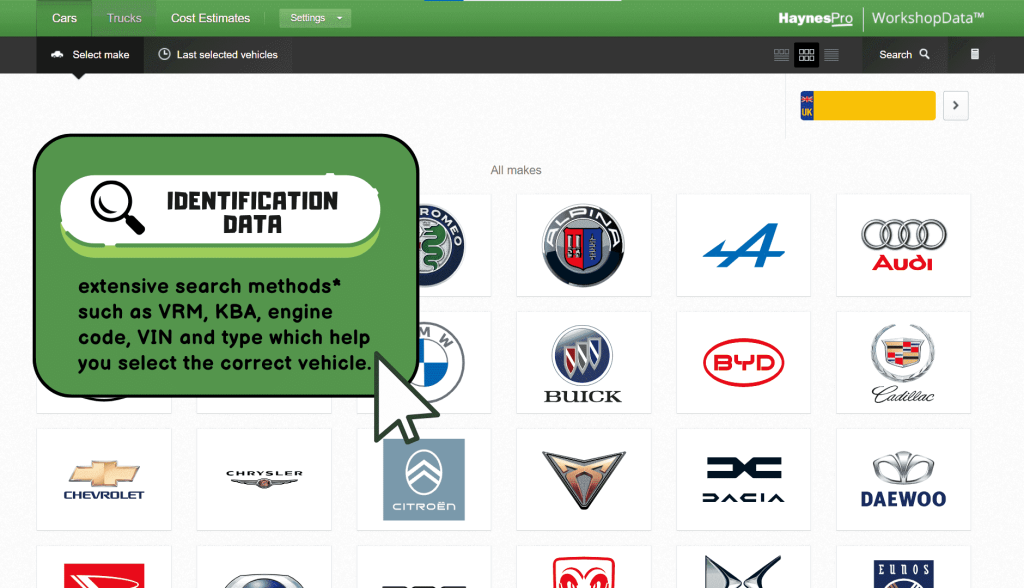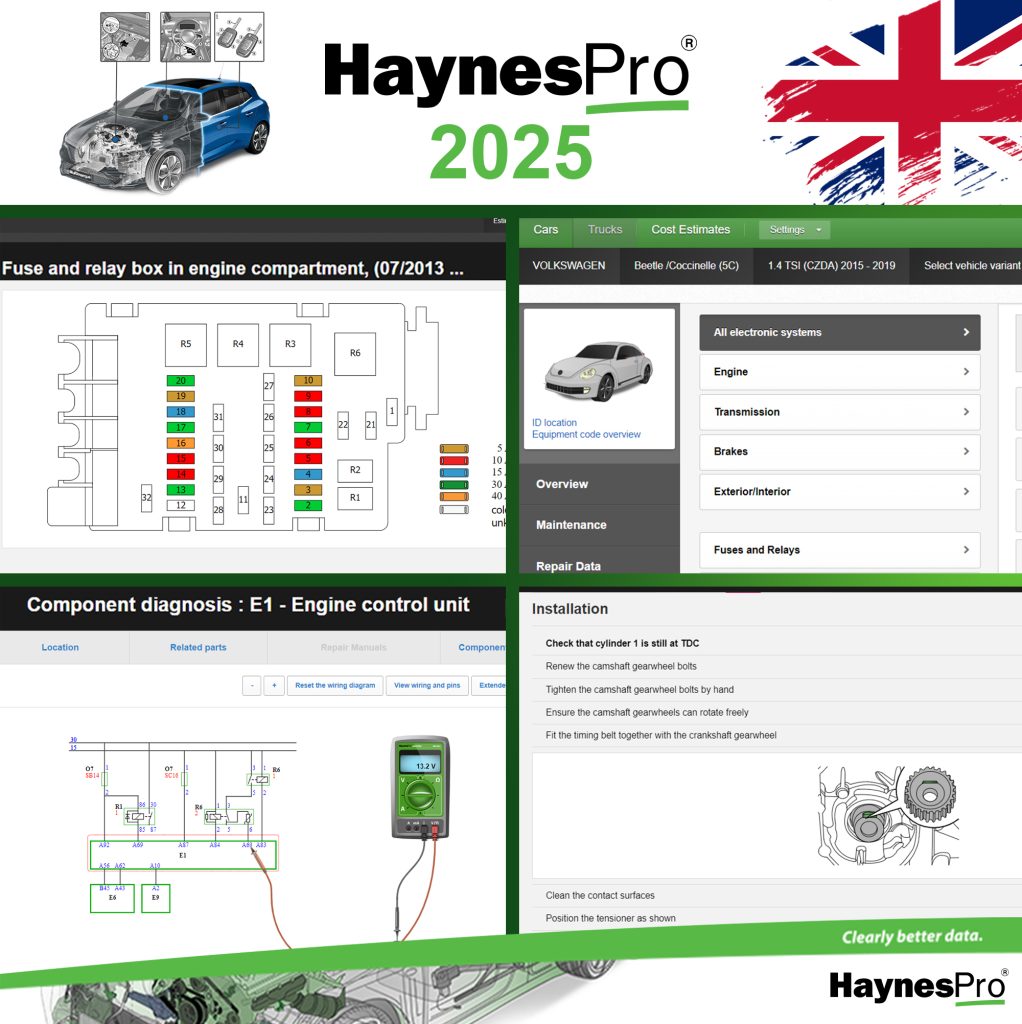The rise of electric and hybrid vehicles (EVs and HEVs) is transforming the automotive industry. With government mandates, strict emissions regulations, and growing consumer demand for greener transportation, workshops and mechanics must adapt to a new era of vehicle diagnostics and repair.
Unlike traditional internal combustion engine (ICE) vehicles, EVs and hybrids introduce high-voltage systems, advanced power electronics, and software-driven diagnostics, requiring specialized expertise and repair tools. However, many workshops are still playing catch-up, struggling with new challenges in battery diagnostics, energy management systems, and electrical repairs.
This is where HaynesPro Electronics provides a critical advantage. It is designed to give technicians instant access to diagnostic and repair information for modern vehicle electrical systems. Equipped with VESA™ guided diagnostics, interactive wiring diagrams, electric component localization, and high-voltage safety procedures, HaynesPro Electronics ensures workshops can confidently service electric and hybrid vehicles with precision and efficiency.
In this article, we explore the evolution of hybrid and EV technology, the challenges technicians face, and how HaynesPro Electronics is helping workshops transition into the future of vehicle diagnostics.
The Evolution of hybrid and EV technology
The Shift Toward Electrification
The push for electrification in transportation is driven by the need to reduce carbon emissions, improve fuel efficiency, and transition away from fossil fuels. Many governments have committed to banning the sale of new gasoline and diesel vehicles by 2035, making EVs and hybrids the future of mobility. As a result, major automakers are investing heavily in battery technology, power electronics, and alternative propulsion systems.
Understanding Hybrid Vehicle Technology
Hybrid vehicles bridge the gap between traditional combustion engines and fully electric drivetrains, offering a combination of fuel efficiency and electric propulsion. While all hybrids integrate both an ICE and an electric motor, they differ in how they generate and use electric power.
- Mild Hybrid Electric Vehicles (MHEVs)
Mild hybrids do not operate solely on electricity but use a small electric motor to assist the engine during acceleration and improve fuel efficiency. These systems feature regenerative braking to recover energy and support the ICE, reducing overall emissions.
- Full Hybrid Electric Vehicles (FHEVs)
Full hybrids, like the Toyota Prius, can run solely on the electric motor, the gasoline engine, or a combination of both. They use power-split transmissions and intelligent energy management systems to seamlessly switch between power sources, optimizing efficiency based on driving conditions.
- Plug-In Hybrid Electric Vehicles (PHEVs)
Plug-in hybrids offer larger battery packs and extended electric range, allowing drivers to recharge from external power sources. These vehicles can operate in pure electric mode for daily commutes but rely on the gasoline engine for longer trips.
The Transition to Fully Electric Vehicles (EVs)
Unlike hybrids, electric vehicles (EVs) rely entirely on electric motors for propulsion. They feature high-voltage battery packs, advanced power electronics, and no internal combustion components. While EVs offer zero emissions and lower maintenance requirements, they present significant challenges in diagnostics, repairs, and battery management.
With EV sales expected to surpass gasoline vehicle sales in the coming decade, workshops must prepare for a new standard of vehicle servicing.
Challenges in EV & Hybrid Vehicle Repairs
High-Voltage Systems and Safety Risks
One of the most significant challenges technicians face is the danger of working with high-voltage components. While traditional ICE vehicles operate on 12V electrical systems, EVs and hybrids use 400V to 800V powertrains, increasing the risk of electrocution, thermal runaway, and fire hazards if not handled correctly.
Technicians must follow strict isolation and shutdown procedures before performing repairs. Improper handling of lithium-ion battery packs can result in serious injury or vehicle damage. This makes manufacturer-approved repair data and step-by-step safety protocols essential.
Complex Powertrain and Battery Diagnostics
Unlike conventional engines, where a misfire or oil leak provides clear mechanical symptoms, EVs and hybrids rely on digital control modules and software-driven alerts to diagnose issues. When an EV malfunctions, it may shut down entirely without warning, requiring precise fault code analysis.
Key diagnostic challenges include:
- Battery degradation and thermal management
- Faults in inverters, converters, and charging systems
- Regenerative braking system malfunctions
- Energy management software errors
Without real-time sensor data and intelligent fault code interpretation, pinpointing these issues can be time-consuming and frustrating.
Hybrid-Specific Repairs and Maintenance
Hybrids present a unique blend of ICE and EV challenges, requiring technicians to service both powertrains simultaneously. One of the biggest difficulties in hybrid repairs is understanding how the two systems interact, particularly in power distribution, braking, and energy recovery systems.
Hybrid vehicles also feature dual braking systems, combining traditional hydraulic brakes with regenerative braking technology. If these systems are not correctly calibrated, brake performance can suffer, affecting vehicle safety.
With fewer moving parts than ICE vehicles but more complex electrical systems, servicing hybrids requires detailed repair data and access to manufacturer-specific procedures.
How HaynesPro Electronics Supports Technicians in EV & Hybrid Repairs
VESA™: Guided Diagnostics for Electrical Systems
Electrical faults in modern vehicles can be difficult to trace, as issues often stem from multiple interconnected systems. Standard OBD-II scanners may only display error codes, without indicating the true source of a failure. This is where HaynesPro’s VESA™ (Vehicle Electronics Smart Assistant) stands out, providing structured diagnostics for complex electronic faults.
How VESA™ Enhances Electrical Diagnostics
- Simultaneous Fault Code Analysis – Technicians can input multiple diagnostic trouble codes (DTCs) at once, allowing VESA™ to prioritize faults and suggest the most efficient troubleshooting path.
- Direct Links to Component Tests – Instead of searching manually, VESA™ connects technicians directly to the relevant components, wiring diagrams, and repair procedures.
- Access to Manufacturer-Specific Fault Codes & EOBD Data – Unlike generic scan tools, VESA™ integrates OEM fault code definitions, providing detailed explanations and verified repair steps.
- Smart Module Configurations – Allows automatic adaptation of control modules, ensuring that electronic replacements are properly configured and functional.
By eliminating guesswork, VESA™ reduces diagnostic time, prevents unnecessary part replacements, and improves workshop efficiency.
See how VESA™ can optimize your diagnostics – Try it for free today!
Electric Component Localization: Pinpointing Electrical Faults
When diagnosing electrical issues, finding the exact location of sensors, control units, relays, and connectors can be time-consuming. HaynesPro simplifies this with its electric component localization feature, providing technicians with precise location data for every critical electronic component.
What Electric Component Localization Includes:
- Inverter, Converter, and Charge Controller Mapping – Essential for hybrid and EV repairs, this ensures that high-voltage components are easily located and serviced.
- ECU, Fuse, and Relay Locations – Direct access to wiring locations for major control modules, power distribution units, and fuses, reducing troubleshooting time.
- EOBD Connector & Grounding Points Identification – Helps technicians quickly find diagnostic ports and ground connections, ensuring proper system communication and reliability.
This feature streamlines troubleshooting by eliminating unnecessary searches, making electrical repairs faster and more precise.
Comfort Wiring Diagrams: Simplifying Complex Electrical Circuits
Modern vehicles contain thousands of interconnected circuits, making electrical faults difficult to trace. HaynesPro’s Comfort Wiring Diagrams provide clear, interactive, vehicle-specific schematics, allowing technicians to navigate wiring layouts efficiently.
Key Benefits of Comfort Wiring Diagrams:
- Localized Wiring Data – Instead of generic schematics, HaynesPro provides manufacturer-specific diagrams tailored to each make and model.
- Zoomable & Interactive Diagrams – Technicians can focus on specific circuits, follow high-voltage connections, and trace wire paths with ease.
- Wiring & Component Tracking – Allows users to quickly locate electrical failures, broken circuits, or misconnected wires.
By offering highly detailed and easy-to-read electrical layouts, HaynesPro reduces diagnostic errors and speeds up electrical repairs.
Stop struggling with complex electrical circuits – Try interactive wiring diagrams with HaynesPro!
Fuses & Relays: Location & Identification
Fuses and relays control critical vehicle functions, including lighting, power windows, engine management, and safety systems. A single blown fuse or faulty relay can disrupt an entire circuit, making precise identification essential for efficient repairs.
How HaynesPro Helps with Fuse & Relay Identification:
- Complete Database of Fuse Box Locations – Eliminates the need for guesswork by providing the exact placement of fuse panels in every vehicle.
- Relay and Fuse Identification Numbers – Ensures technicians replace the correct component, preventing unnecessary replacements and repeat failures.
- Link to Fault Code Diagnostics – Allows direct correlation between system failures and blown fuses, reducing diagnostic time.
By organizing all fuse and relay data in a single interface, HaynesPro enhances efficiency and prevents misdiagnoses.
Battery Disconnection & Reconnection Procedures
Handling modern vehicle batteries—especially in EVs and hybrids—requires strict adherence to manufacturer safety guidelines. Incorrectly disconnecting a battery can result in system errors, loss of critical data, or even damage to vehicle electronics.
What HaynesPro Provides for Battery Service:
- Step-by-Step Battery Disconnection & Reconnection Guides – Prevents damage to ECUs, security systems, and infotainment components.
- Manufacturer-Recommended Shutdown Sequences – Ensures that power is safely deactivated before servicing.
- Guidance on Personal Protective Equipment (PPE) – Helps technicians handle high-voltage batteries safely, reducing electrical hazards.
With structured disconnection protocols, HaynesPro helps workshops service EV and hybrid batteries confidently and safely.
High-Voltage Circuit Deactivation Procedures
Hybrid and electric vehicles operate at dangerously high voltages, ranging from 400V to 800V. Before servicing power inverters, traction motors, or high-voltage batteries, technicians must isolate and discharge circuits properly.
How HaynesPro Ensures Safe High-Voltage Repairs:
- Model-Specific Deactivation Instructions – Step-by-step guides ensure that technicians safely isolate high-voltage components before performing any repairs.
- Warnings for Residual Energy Risks – Some high-voltage systems retain charge even after shutdown; HaynesPro alerts technicians to these hidden dangers.
- Integration with Comfort Wiring Diagrams – Technicians can cross-reference deactivation steps with vehicle-specific schematics, ensuring circuits are completely safe before service.
By following HaynesPro’s high-voltage deactivation procedures, technicians eliminate safety risks and ensure compliance with EV repair standards.
Why HaynesPro Electronics is Essential for Modern Workshops
The shift toward EVs and hybrids is happening now, and workshops that fail to adapt risk losing customers. Servicing these advanced vehicles requires more than just mechanical expertise—it demands intelligent, data-driven diagnostics.
HaynesPro Electronics provides the ultimate EV and hybrid repair solution, equipping technicians with:
- VESA™ for guided electrical diagnostics and smart fault detection
- Electric component localization for quick and accurate troubleshooting
- Comfort wiring diagrams to simplify intricate electrical systems
- Fuses & relays database for faster identification and replacements
- Battery disconnection & reconnection guides to protect vehicle ECUs
- High-voltage circuit deactivation protocols to ensure technician safety
By providing real-time access to essential electrical data, HaynesPro reduces repair times, prevents misdiagnoses, and enhances workshop efficiency.








